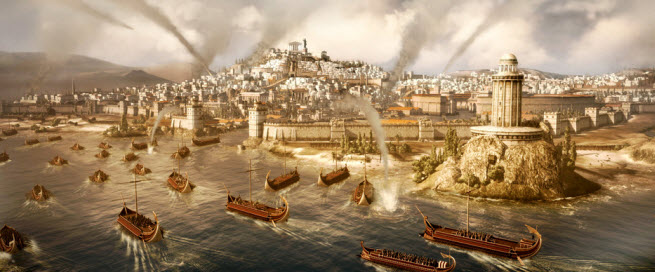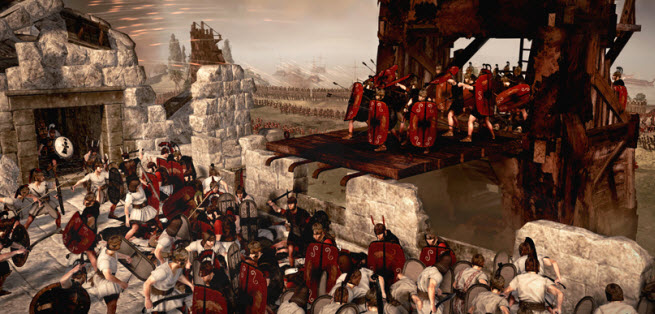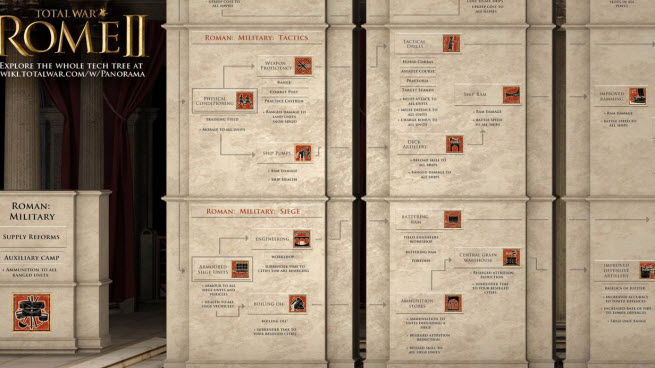Outstanding 3D graphics
Within the real-time battles, you can zoom in on individual soldiers fighting and pull up to a board-game style view from above. But most of your practical battle management will take place at an angled 3D view, just above your forces. You can zoom in and out with the mouse wheel, and the game responds in a fluid fashion. You can get about 2,000 soldiers on the battlefield in a single formation. That doesn’t seem like much, but it is a good choice by Creative Assembly because it’s harder to control a huge army. But you can still get more of your own soldiers into a fray by positioning several armies together. Once you attack with one, the others will show up as reinforcements who run onto the battlefield in real time against you. I had one battle with more than 5,000 soldiers fighting on my side, and you can get more than that if you like.
But the terrain plays a big factor as well. Like the armies, the landscapes are all beautifully animated. You can fight in dense forests, deserts, or detailed cities. The provincial capitals have their own walls, towers, gates, temples, monuments, squares, and quays. The combat takes place along broad avenues that can become bottlenecks that are defended by a single unit, if necessary. Rain or fog can completely change the nature of the battle as soldiers can bog down and become tired in a torrent or lose sight of the enemy entirely in dense fog. The visual weather changes are top-notch, too.
What you won’t like
The human face animations aren’t perfect
I’ve already mentioned that the enemies can be really dumb on occasion. But there are a few other flaws.
Rome II’s great promise was that it would show you combat from the individual soldier to the giant bird’s-eye view of the army. But the animated faces in the cutscenes — done within the Rome II engine — fall a little short of the best that we’ve seen in gaming.
As with most video games, the human faces are far from perfect when it comes to animation quality. In the cutscenes, the lip sync isn’t always a match, and the facial expressions of the characters are somewhat limited. The cinematics often catch the individual views of a pack of soldiers attacking each other in one big mass of limbs and bodies. You have to look for a while to figure out any useful information, like which side is winning a melee.
I have to say that this isn’t quite like watching a movie like Braveheart yet and feeling like you are inside the movie, on the battlefield. That day will come, but the facial animations are the barrier that the developers must conquer one of these days.
The occasional bugs
The game crashed on me once, but I didn’t lose anything. I simply rebooted and continued from the place where I left off. The saving system seemed to work fine for me. Others have noticed small glitches like a spy walking across the water rather than sailing in a boat or slow framerates during a three-way multiplayer battle. But I actually didn’t encounter major problems in the single-player campaign. The greater frustrations come from the performance.
The slow sweep of turns
Rome II is a lot like the Civ games, especially late in a campaign, where it seems to take forever to execute and finish the turns.
After you end your turn, every faction has to make its move. And because many of these turns could be relevant to you, Rome II tries to graphically show you what many of the visible factions are doing. This is a necessary but wasteful part of the game. It seems like Creative Assembly should figure out a way to process those moves in the background while you’re still able to do something within the game.
I played the title on a fairly hefty PC (the Toshiba Qosmio X875 with an Intel Core i7-3610QM running at 2.3 gigahertz with 16 gigabytes of RAM and 64-bit Windows 7 Home Premium), but the turns still ran slow. When you’re cruising across the landscapes, you’ll notice that the performance slows on occasion. But for the most part, the game ran fine in real-time battles, where it counts most.
An economy that won’t keep up with your ambitions
Sometimes there’s a mismatch in your willingness to wage war and your ability to fight it. Your ability to recruit soldiers depends on how well you manage the economy. And it’s hard to tell exactly how much you should be investing in it versus your military might. When your economy goes into the dumps, it’s hard to turn it around.
Your citizens starve, and they revolt. Then your expansion grinds to a halt, and you fall behind your rivals in acquiring new territory. Rome II just doesn’t give you enough warnings about how to govern your empire in a balanced way. As a result, you have to go through a trial-and-error process. You tweak your economy little by little, and you build your armies little by little — even though you would rather move faster. The tech tree, pictured above, also seems a little clunky and doesn’t convey as much information as it should.
That could be avoided if the economic indicators were there to give you that warning or if Creative Assembly did a better job of explaining the game’s economics to you. I would really appreciate it if it had more Civilization-style leaderboards to show me at a glance the factions that matter instead of just a list of all of the factions. In fact, I would be happy if the game told me, “Sorry, you have absolutely no hope of winning this game right now, and you really should start over.” That might save me 30 hours of trying to revive a dying empire or republic.




